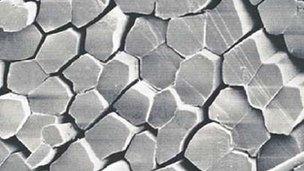Spider silk spun into violin strings
- Published

More than 300 spiders were used to generate the thousands of strands of silk making up each string
A Japanese researcher has used thousands of strands of spider silk to spin a set of violin strings.
The strings are said to have a "soft and profound timbre" relative to traditional gut or steel strings.
That may arise from the way the strings are twisted, resulting in a "packing structure" that leaves practically no space between any of the strands.
The strings will bedescribed in a forthcoming edition of the journal Physical Review Letters, external.
Shigeyoshi Osaki of Japan's Nara Medical University has been interested in the mechanical properties of spider silk for a number of years.
In particular, he has studied the "dragline" silk that spiders dangle from, quantifying its strength in a2007 paper in Polymer Journal, external.
Dr Osaki has perfected methods of obtaining large quantities of this dragline silk from captive-bred spiders and has now turned his attention to the applications of the remarkable material.
"Bowed string instruments such as the violin have been the subject of many scientific studies," he writes.
"However, not all of the details have been clarified, as most players have been interested in the violin body rather than the properties of the bow or strings."
Dr Osaki used 300 femaleNephila maculataspiders - one of the species of "golden orb-weavers" renowned for their complex webs - to provide the dragline silk.
For each string, Dr Osaki twisted between 3,000 and 5,000 individual strands of silk in one direction to form a bundle. The strings were then prepared from three of these bundles twisted together in the opposite direction.
He then set about measuring their tensile strength - a critical factor for violinists wishing to avoid breaking a string in the midst of a concerto.
The spider-silk strings withstood less tension before breaking than a traditional but rarely used gut string, but more than an aluminium-coated, nylon-core string.

An electron microscope image shows a section of the bundle just 70 millionths of a metre wide
A closer study using an electron microscope showed that, while the strings themselves were perfectly round, in cross-section the strands had been compressed into a range of different shapes that all fit snugly together, leaving no space between them.
Dr Osaki suggests that it is this feature of the strings that lends them their strength and, crucially, their unique tone.
"Several professional violinists reported that spider strings... generated a preferable timbre, being able to create a new music," he wrote.
"The violin strings are a novel practical use for spider silk as a kind of high value-added product, and offer a distinctive type of timbre for both violin players and music lovers worldwide."
- Published24 January 2012
- Published17 January 2012
- Published4 January 2012